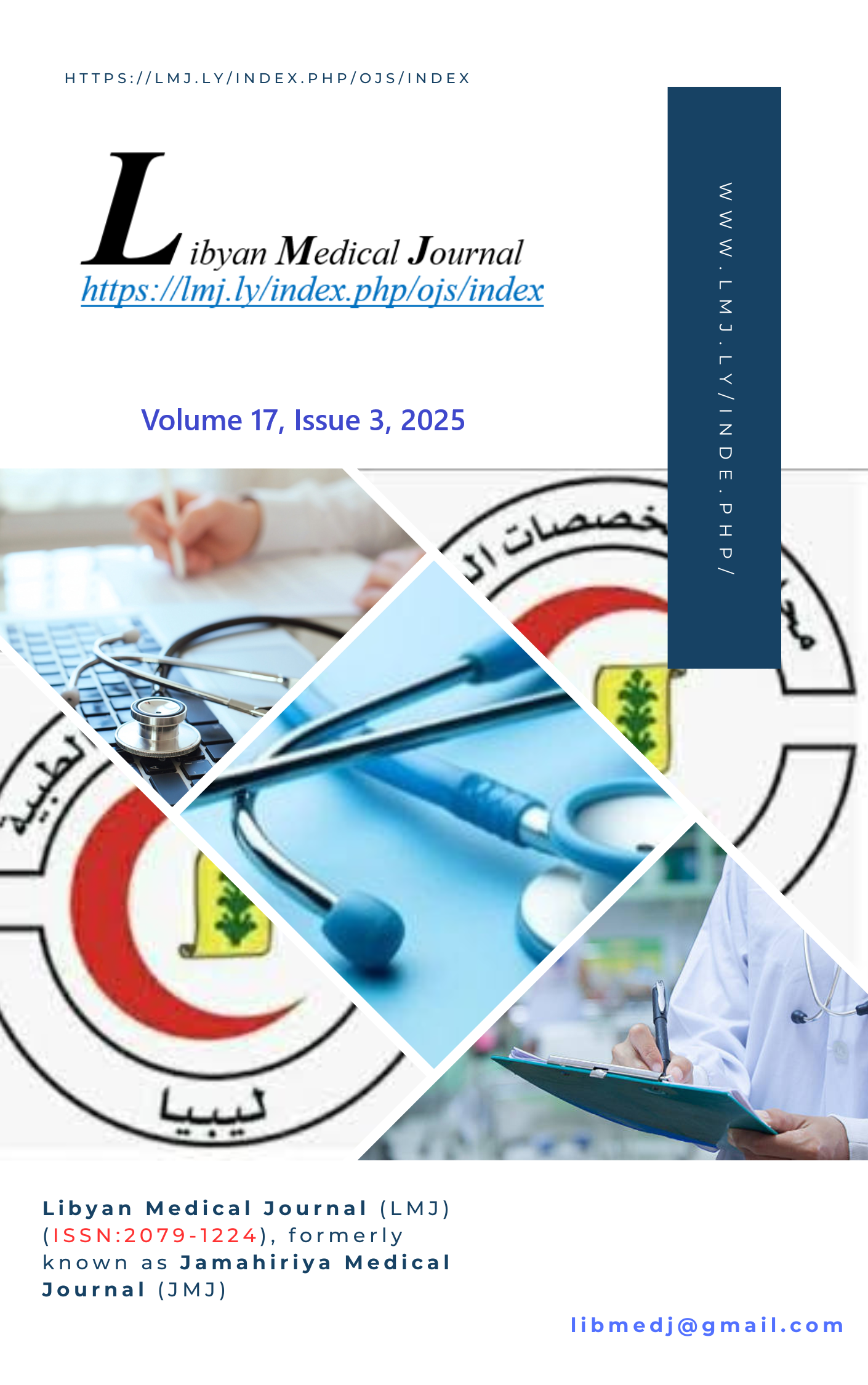Profile of Clinical and Bacteriological Findings in Diabetic Foot Infections at a Tertiary Care Centre, 2025
DOI:
https://doi.org/10.69667/lmj.2517322Keywords:
Diabetic Foot Infection, Staphylococcus, Susceptibility.Abstract
Diabetic foot infections are a serious global health concern and a common occurrence in daily life. One of the primary reasons why diabetes individuals experience morbidity is diabetic foot infections (DFIs), which frequently necessitate hospitalization and may even result in amputation. The objective of this study was to identify the most frequent cause of diabetic foot infections and ulcers, treat them with the appropriate antibiotic, and reduce the need for amputation. Additionally, depending on sensitivity and culture, we should establish guidelines for the administration of an empirical antibiotic regimen in our area. Fifty-two individuals with diabetes have been selected using a convenience sampling strategy from the emergency room (ER) and clinics. The diagnosis of type 2 diabetes can be detected in patients with elevated HbA1c (> 7%), elevated blood glucose levels (fasting blood glucose > 100 mg/dl and random blood glucose > 180 mg/dl), and presenting with infection according to Wegener grade 2–5,13 wounds, and have not yet received systemic antibiotic therapy within a week. Both aerobic and anaerobic microbiological methods were used to collect and cultivate the culture specimens. The isolates' sensitivity to widely used antibiotic treatment was examined. The most sensitive antibiotics to the Klebsiella organism were ciprofloxacin, azithromycin, chloramphenicol, and meropenem. The most sensitive antibiotics to Staphylococcus organisms included amikacin, imipenem, rifampin, cefoxitin, doxycycline, nitrocefin, and levofloxacin. The antibiotics that are most sensitive to the Escherichia coli organism were Ciprofloxacin, Levofloxacin, Tetracycline, Gentamicin, Cephalexin, Vancomycin, and Meropenem. The antibiotic that was most sensitive to Serratia organisms was chloramphenicol. Gram-positive bacteria like Staphylococcus aureus or polymicrobial infections were the primary causes of diabetic foot infections
References
Goyal R, Singhal M, Jialal I. Type 2 Diabetes. In: StatPearls [Internet]. Treasure Island (FL): StatPearls Publishing; 2023.
Elbaruni K, Abdulwahed E, Khalfalla W, Alsudany R, Jerbi R, Alwaseea N, et al. Association between some inflammatory markers and HbA1c in patients with type 2 diabetes mellitus. AlQalam J Med Appl Sci. 2023 Mar 31;:137–41.
Almestiri S, Alahmer A, Gemayel A, Abushkiwa M, Al Wadidi O, Beleed O, et al. Assessment of hematological parameters and glycated hemoglobin of diabetic patients in Zliten Center for Diabetes. Attahadi Med J. 2024 Jul 23;:39–42.
Noor S, Khan RU, Ahmad J. Understanding diabetic foot infection and its management. Diabetes Metab Syndr. 2017 Apr-Jun;11(2):149–56.
Lipsky BA. A report from the international consensus on diagnosing and treating the infected diabetic foot. Diabetes Metab Res Rev. 2004 May-Jun;20 Suppl 1:S68–77.
Shah P, Inturi R, Anne D, Jadhav D, Viswambharan V, Khadilkar R, et al. Wagner's classification as a tool for treating diabetic foot ulcers: our observations at a suburban teaching hospital. Cureus. 2022 Jan;14(1):e21510.
Khalifa W, Al-Griw H, Shamsi S, Aboubaker H, Rehoumah K. Plasmid-mediated resistance and biofilm formation in Gram-negative diabetic foot ulcer infections. AlQalam J Med Appl Sci. 2025 Jul 6;:1322–9.
Akhi MT, Ghotaslou R, Asgharzadeh M, Varshochi M, Pirzadeh T, Memar MY, et al. Bacterial etiology and antibiotic susceptibility pattern of diabetic foot infections in Tabriz, Iran. GMS Hyg Infect Control. 2015;10:Doc02.
Dezfulian A, Salehian MT, Amini V, Dabiri H, Azimi Rad M, Aslani MM, et al. Bacteriological study of diabetic foot infections in an Iranian hospital. Iran Red Crescent Med J. 2011 Aug;13(8):590–1.
Daniel J, Gowthami E, Sowmiya S. Isolation and identification of bacterial pathogens from wounds of diabetic patients. Int J Curr Microbiol Appl Sci. 2013;2(12):72–7.
Gadepalli R, Dhawan B, Sreenivas V, Kapil A, Ammini AC, Chaudhry R. A clinico-microbiological study of diabetic foot ulcers in an Indian tertiary care hospital. Diabetes Care. 2006 Aug;29(8):1727–32.
Salihu MK, Yarima A, Atta HI. Methods for the phenotypic detection of extended spectrum beta lactamase (ESBL)-producing bacteria. Niger J Biotechnol. 2020 Dec;37(2):113–25.
Galal YS, Khairy WA, Taha AA, Amin TT. Predictors of foot ulcers among diabetic patients at a tertiary care center, Egypt. Risk Manag Healthc Policy. 2021 Sep;14:3817–27.
Boschetti G, Sgarabotto D, Meloni M, Bruseghin M, Whisstock C, Marin M, et al. Antimicrobial resistance patterns in diabetic foot infections: an epidemiological study in northeastern Italy. Antibiotics (Basel). 2021 Oct;10(10):1241.
Otta S, Debata NK, Swain B. Bacteriological profile of diabetic foot ulcers. Chrismed J Health Res. 2019 Jan-Mar;6(1):7–11.
Abu-El-Azayem AK, Nashaat N, Dwedar RA, Fekry KM, Bassyouni RH, Hegab AS. Microbiological profile of diabetic foot infections. Microbes Infect Dis. 2024;5(4):1530–40.
Ismail AA, Meheissen MA, Abd Elaaty TA, Abd-Allatif NE, Kassab HS. Microbial profile, antimicrobial resistance, and molecular characterization of diabetic foot infections in a university hospital. Germs. 2021 Mar;11(1):39–52.
Dang CN, Prasad YD, Boulton AJ, Jude EB. Methicillin-resistant Staphylococcus aureus in the diabetic foot clinic: a worsening problem. Diabet Med. 2003 Feb;20(2):159–61.
Mantey I, Hill RL, Foster AV, Wilson S, Wade JJ, Edmonds ME. Infection of foot ulcers with Staphylococcus aureus associated with increased mortality in diabetic patients. Commun Dis Public Health. 2000 Dec;3(4):288–90.
Wang SH, Sun ZL, Guo YJ, Yang BQ, Yuan Y, Wei Q, et al. Meticillin-resistant Staphylococcus aureus isolated from foot ulcers in diabetic patients in a Chinese care hospital: risk factors for infection and prevalence. J Med Microbiol. 2010 Oct;59(Pt 10):1219–24.
Abdulrazak A, Bitar ZI, Al-Shamali AA, Mobasher LA. Bacteriological study of diabetic foot infections. J Diabetes Complications. 2005 May-Jun;19(3):138–41.
Singh SK, Gupta K, Tiwari S, Shahi SK, Kumar S, Kumar A, et al. Detecting aerobic bacterial diversity in patients with diabetic foot wounds using ERIC-PCR: a preliminary communication. Int J Low Extrem Wounds. 2009 Dec;8(4):203–8.
Fish DN. Meropenem in the treatment of complicated skin and soft tissue infections. Ther Clin Risk Manag. 2006 Dec;2(4):401–15.
Nageen A. The most prevalent organism in diabetic foot ulcers and its drug sensitivity and resistance to different standard antibiotics. J Coll Physicians Surg Pak. 2016 Apr;26(4):293–6.











